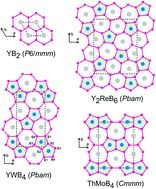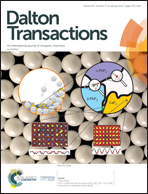11B and 89Y solid state MAS NMR spectroscopic investigations of the layered borides YTB4 (T = Mo, W, Re)†
Abstract
The YCrB4 type borides YTB4 (T = Mo, W, Re) were synthesized from the elements by arc-melting and subsequent annealing. The structures were refined from single crystal X-ray diffractometer data: Pbam, a = 602.84(8), b = 1164.5(1), c = 361.20(4) pm, wR2 = 0.0404, 624 F2 values, 26 variables for YMoB4, a = 603.00(7), b = 1165.1(1), c = 360.63(6) pm, wR2 = 0.0487, 474 F2 values, 26 variables for YWB4, and a = 596.67(6), b = 1154.4(1), c = 360.21(4) pm, wR2 = 0.0465, 544 F2 values, 26 variables for YReB4. The boron atoms build up planar networks which are a tessellation of slightly distorted pentagons and heptagons. Adjacent networks coordinate the transition metal and yttrium atoms in the form of pentagonal and heptagonal prisms, respectively. The four crystallographically distinct boron sites are differentiated by high-resolution 11B solid state isotropic magnetic shifts and nuclear electric quadrupolar coupling constants. Partial site assignments are possible based on comparisons with electric field gradient calculations using the WIEN2k code. 89Y MAS NMR spectroscopic studies suggest substantially weaker Knight shift contributions to the resonance frequencies when compared to other intermetallic yttrium compounds, including other ternary yttrium boride compounds measured previously.



 Please wait while we load your content...
Please wait while we load your content...